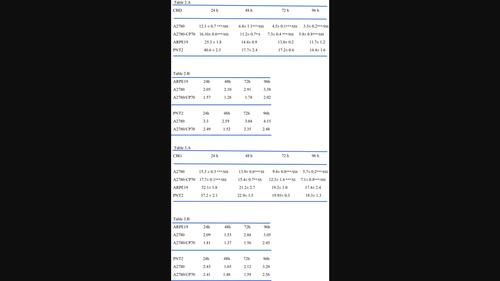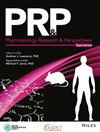大麻素对人类卵巢癌细胞诱导的细胞毒性研究
IF 2.9
4区 医学
Q2 PHARMACOLOGY & PHARMACY
引用次数: 0
摘要
研究表明,大麻素能诱导乳腺癌、前列腺癌和脑癌等多种癌细胞产生抗肿瘤活性。本研究旨在探讨大麻素、CBD(大麻二酚)和 CBG(大麻酚)在对化疗药物敏感和耐药的卵巢癌细胞中的抗肿瘤活性。敏感的 A2780 细胞和耐药的 A2780/CP70 癌细胞以及非癌细胞在不同的暴露时间内分别单独或联合暴露于不同浓度的 CBD、CBG、卡铂或 CB1 和 CB2 受体拮抗剂 AM251 和 AM630,并通过 MTT 试验测定细胞毒性。CBD 和 CB 诱导细胞毒性的作用机制通过多种细胞凋亡和细胞周期检测方法进行了研究。CBD 和 CBG 可选择性地、按剂量和时间降低细胞活力并诱导细胞凋亡。在所有测试的细胞系中,CBD 的作用都强于 CBG。在耐药细胞中,CBD 和 CBG 诱导的细胞毒性均强于卡铂。在两种癌细胞中,CBD 诱导的细胞毒性都不依赖于 CB1 或 CB2 受体,但在顺铂耐药癌细胞中,CBG 诱导的细胞毒性可能涉及 CB1 受体的活性。当亚致死剂量的大麻素与卡铂结合使用时,在这两种癌细胞中都观察到了协同效应。凋亡事件可能涉及线粒体膜电位丧失、Annexin V、caspase 3/7、ROS 活性和细胞周期停滞。这些结果能否应用于临床还需要进一步研究。建议使用大麻素与传统癌症治疗方法相结合。本文章由计算机程序翻译,如有差异,请以英文原文为准。

Investigation of the cytotoxicity induced by cannabinoids on human ovarian carcinoma cells
Cannabinoids have been shown to induce anti-tumor activity in a variety of carcinoma cells such as breast, prostate, and brain. The aim of the present study is to investigate the anti-tumor activity of cannabinoids, CBD (cannbidiol), and CBG (cannabigerol) in ovarian carcinoma cells sensitive and resistant to chemotherapeutic drugs. Sensitive A2780 cells and resistant A2780/CP70 carcinoma cells and non-carcinoma cells were exposed to varying concentrations of CBD, CBG, carboplatin or CB1 and CB2 receptor antagonists, AM251 and AM630, respectively, alone or in combination, at different exposure times and cytotoxicity was measured by MTT assay. The mechanism of action of CBD and CB in inducing cytotoxicity was investigated involving a variety of apoptotic and cell cycle assays. Treatment with CBD and CBG selectively, dose and time dependently reduced cell viability and induced apoptosis. The effect of CBD was stronger than CBG in all cell lines tested. Both CBD and CBG induced stronger cytotoxicity than afforded by carboplatin in resistant cells. The cytotoxicity induced by CBD was not CB1 or CB2 receptor dependent in both carcinoma cells, however, CBG-induced cytotoxicity may involve CB1 receptor activity in cisplatin-resistant carcinoma cells. A synergistic effect was observed when cannabinoids at sublethal doses were combined with carboplatin in both carcinoma cells. The apoptotic event may involve loss of mitochondrial membrane potential, Annexin V, caspase 3/7, ROS activities, and cell cycle arrest. Further studies are required to investigate whether these results are translatable in the clinic. Combination therapies with conventional cancer treatments using cannabinoids are suggested.
求助全文
通过发布文献求助,成功后即可免费获取论文全文。
去求助
来源期刊

Pharmacology Research & Perspectives
Pharmacology, Toxicology and Pharmaceutics-General Pharmacology, Toxicology and Pharmaceutics
CiteScore
5.30
自引率
3.80%
发文量
120
审稿时长
20 weeks
期刊介绍:
PR&P is jointly published by the American Society for Pharmacology and Experimental Therapeutics (ASPET), the British Pharmacological Society (BPS), and Wiley. PR&P is a bi-monthly open access journal that publishes a range of article types, including: target validation (preclinical papers that show a hypothesis is incorrect or papers on drugs that have failed in early clinical development); drug discovery reviews (strategy, hypotheses, and data resulting in a successful therapeutic drug); frontiers in translational medicine (drug and target validation for an unmet therapeutic need); pharmacological hypotheses (reviews that are oriented to inform a novel hypothesis); and replication studies (work that refutes key findings [failed replication] and work that validates key findings). PR&P publishes papers submitted directly to the journal and those referred from the journals of ASPET and the BPS
 求助内容:
求助内容: 应助结果提醒方式:
应助结果提醒方式:


